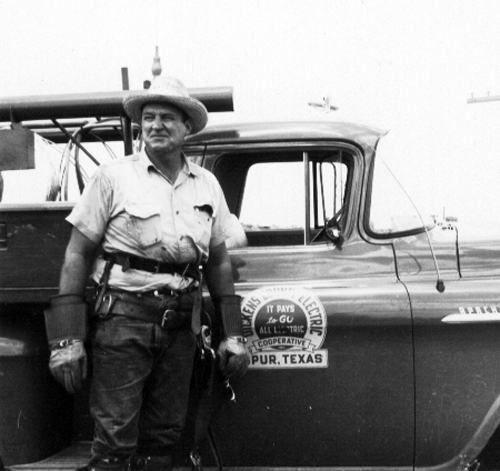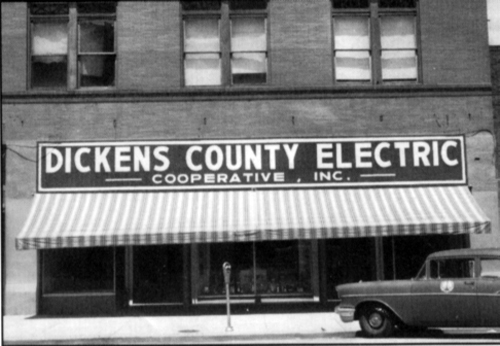Dickens Electric Cooperative (DEC) was born from the dreams and desires of area pioneers. Although DEC was not one of the original businesses when the City of Spur was established, it has become an important part of the community.
The possibility of providing electrical energy to rural areas by an electric cooperative was first discussed by Mr. Joe Rose and Mr. John Sharp in late 1939.
One of the first items concerning the establishing of an electric cooperative was a letter dated December 19, 1939, to Mr. C.O. Falkewald, who was with the examing division of the Rural Electrification Administration (REA), Washington, D.C., from Mr. L.D. Ratliff, Jr., of Spur, Texas.
Mr. Ratliff, then county attorney, stated that he had been designated correspondent for a committee of farmers who were interested in rural electrification in Dickens, Kent and Motley counties. One of the first steps in organizing a cooperative was to select and receive approval for a project attorney from the legal department of REA. Also, nine men were to be selected to act as original incorporators. A charter also had to be acquired from the State of Texas. The nine appointed original incorporators of the newly organized cooperative were Mr. Joe Rose of Roaring Springs, president; Mr. J.P. Sharp of Spur, secretary; Mr. C.V. O'Keefe of Girard; Mr. E.J. Offield of Afton; Mr. W.H. Hindman of Spur; Mr. M.B. Gage of Afton; Mr. E.F. Shugart of Spur; Mr. W.B. Lang of Jayton and Mr. Les Smith of Roaring Springs.
Mr. Ratliff was appointed project attorney and filed for a charter with the secretary of the State of Texas. This charter was granted on February 10, 1940. The newly appointed board held its first meeting February 24, 1940, L.D. Ratliff's office in Spur Security Bank. The chairman reported that the original copy of the Articles of Incorporation was filed on February 10, 1940, and the secretary of state had issued a Certificate of Incorporation.
This Certificate of Incorporation authorized them to start soliciting members. They held meetings in school buildings and signed up anyone in the rural areas of Dickens, Kent, Stonewall, King, Motley, Crosby and Garza counties who was not already receiving electric power from another source, was willing to sign an easement and pay $5 for the membership fee. Prospective members also had to own a certain number of cows, hogs, chickens or sheep so that paying their bills would be feasible. Mr. W.H. Hindman, also a member on the board of directors, has the honor of holding the first membership.
During this time, Mr. H.M. Roberts was selected by the board of directors as the project engineer. His job was to take the membership applications and map the residences signed up, and also the ones which were not, designating the homes which were to receive electricity.
The Cooperative's first loan application was submitted to the REA in March 1941. Approval of this loan was finally granted in December 1941. However, because of the outbreak of World War II, the Cooperative did not receive loan funds until 1944.
When the war was finally over, Mr. Robert Kuykendall was hired as the first manager in November 1944 and the Dickens County Electric Cooperative moved into its first office during the same month. The office was located in the Roy Stovall Building from 1944 until 1956.
Mrs. Helen Williams was hired in November 1944 as the first cashier. Of the first office, she remembers that they had no pencils, one typewriter, no screens on the doors, but plenty of flies. Although everything was seemingly ready to begin, there still were not enough people signed up as members in order that the loan might be received. Postwar poverty did not help matters any. Mr.Ratliff had this to say about the difficulty of the times: "Times were hard. We couldn't get people to pay the $5 membership fee because they just didn't have $5. Also, they just didn't believe they could ever get electricity."
Finally enough people did sign up for membership, and the first loan was received on November 21, 1944. In the meeting of the board of directors on that same day, bids for the construction of 75 miles of electric line were received. The bid for $57,629.38, submitted by the Eugene Ashe Electric Company, was accepted, it being the lowest. Construction soon began on the first line, erected east of Spur.
Just when everything was running relatively smoothly, Mr. Kuykendall reported in a board meeting on March 3, 1945, that he was being drafted into the armed services, and that the Cooperative would be needing a new manager. The board decided that they would advertise for a manager in the Fort Worth Star Telegram and the Lubbock Avalanche Journal; however, the new manager chosen on March 31, 1945, was Mr. Jack Rector, a local resident.
In a meeting on May 19, 1945, it was reported that the original loan of $179,000 would not be sufficient to complete construction of lines and properties and that an additional loan of $100,000 was required. This loan was granted and received, and the construction of the new electric lines continued. The first loan in the amount of $179,000 was used to finance the construction of 255 miles of electric line to serve 500 homes. One of the first homes to receive electric power from the Cooperative was that of Mr. and Mrs. Ben H. Dyer, who lived between Girard and Jayton, in September 1945. Their first bill amounted to the sum of $2 (instead of the 32 kilowatt, $2.95 minimum as he did not receive a full month's service). Within a year, 323 homes had been connected and were receiving electricity.
Electricity was so new to these rural people that many did not understand it or use it to its full capacity. To the majority of the people, it was a source of amazement. A common occurrence was for a family who had just received electric power to turn on every light in the house at night and go outside and stare at the wonderful sight. And there were families who would turn on all the lights if they heard a car coming down the road. They had electricity and they wanted everyone to know it!
Most of the homes had only a few bare light bulbs, but several of the more modern, up-to-date homes had the luxury of an electric iron, a refrigerator and a percolator. The majority of the members did not even go over the $2.95 minimum for usage. If the minimum was reached a few days before the end of the month, off went everything until the next month.
Mr. Edd Brown, one of the first to have Cooperative electricity in Kent County thought at first that he had been gypped. When asked why, he replied, "Cause I was ignorant." He even asked Bill Kimbrough, the Crosby County agent at that time, what he thought about the Cooperative electricity, and Mr. Kimbrough also thought that it was not anything to get excited about. Mr. Brown only had six lights first, and he did not go over the 32 kWh minimum. He then used approximately 600 kWh and thought the Cooperative electricity was the best thing ever.
The first annual meeting, held on March 1, 1946, was a symbol of progress itself. The obstacles of a newly organized cooperative had been met and overcome, and the first line completed and energized. Mr. Rose, the president of the board of directors, presided at the meeting and told of the delays encountered. Mr. Kuykendall, who had returned from the armed forces and assumed his position as manager, gave a report on the trouble encountered in securing labor and materials. Because of a law passed at the close of World War II stating that no county official could serve on a cooperative board of directors, several of the members were not eligible for re-election to the board. The new directors chosen were Joe Rose, S.L. Benefield, Fred Dawson, C.V. O'Keefe, J.R. Speights, W.L. Buckelew, C.R. Gage, Bert Wallace and J.P. Sharp.
On Friday, April 24, 1964, 15 miles of transmission line to the Kalgary substation were energized. This served one of the most important areas in the Dickens County Electric Cooperative field, the Dr. Dunn Oilfield. On Thursday, April 23, 1964, a new interconnected substation near Jayton was completed and energized. It also served oil fields in the Jayton-Clairemont area. The newly completed White River Dam Project was fed electrical power by three sources of the Cooperative's electricity.
In 1956 the Cooperative moved its office to the Reed-Stovall Building, where it remained until 1965. In 1962, Dickens Electric purchased 14.9 acres of land on the west edge of Spur from Mr. Cliff Bird. The purchase of this property allowed the Cooperative to build its own, much needed headquarters facilities. The directors accepted the low bid, which was from Rose Construction Co. of Abilene, Texas, for $171,550. Up until 1965, when construction on the new office and warehouse facilities was completed, the Cooperative operated from rented buildings and grounds that were scattered throughout Spur.
The present spacious and modern office building, still located on the western edge of Spur, is the result of a remodeling and building expansion program undertaken in 1977.
The Cooperative's initial loan of $179,000 from the REA was the beginning of a successful history for DEC. From the first 17 miles of line energized, the Cooperative grew to more than 2,650 miles of line serving 4,530 meters in Crosby, Garza, Motley, Kent, King, Stonewall and Dickens counties. DEC merged with South Plains Electric Cooperative in 1999.





